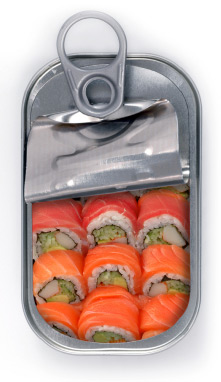
I was at an Italian restaurant the other evening with friends, a rather upscale establishment started by a well-known celebrity chef (since New York needs more of these restaurants). Looking for great seafood and not having eaten there yet, it was a perfect choice to meet, and we were all eager to try it out. The menu was enticing, varied, and upon reflection, strange. The appetizer list had a section of raw fish, some ceviche style, and some purely raw, but some of the items were not listed by their Italian names (what I expected) nor their English names (what I also would have expected), but by their Japanese names.
I ended up ordering hamachi sashimi in a somewhat upscale Italian restaurant, and it became one of many sushi items I had that evening. The fish was not sliced in the same manner as sushi would be, nor was it the same cut (portion) of the fish that is normally used to make sushi/sashimi. It was also not served in the manner of sushi or sashimi. Yet it was labeled as such. It was quite tasty, but I cannot fathom why they would list it as hamachi instead of yellowtail. It seemed odd to find an item referred to in the third party language without context in an Italian restaurant.
When Italian restaurants list items under their Japanese names, and sushi is available at 7-11 stores, I start to wonder what has changed. While there is certainly no rule that sushi and sashimi must remain in a Japanese restaurant, and that the terms be restricted to such use, it seems more than out of place to find such a dish, and the use of the terminology, in such surprising places. When something has become so pervasive that it can no longer be separated from its counterparts, I question one’s ability to define it.
It dilutes the brand, and shows how pervasive it has become that it has jumped from exotic, to mainstream, and then possibly to boring. That said, there is nothing uninspiring about a lengthy and adventurous dinner at Sushi Yasuda in New York, yet still, perhaps, when a once exotic food has so ingrained itself in another culture it becomes something different entirely. Something that only in name retains its roots. What that thing is though is to me uncertain as becomes easy to lose the qualities that make it exotic fare.
We need the great traditional Japanese restaurants such as Sushi Yasuda, and the impressive sushi works of Nobu to keep the art and evolution of good sushi and sashimi ever present in our cultural palate. We need reminders that what to westerners is exotic fare can evolve and remain such, and hopefully there will be no need to lament what sushi has become. Some foods and cultures mix exceptionally well, such as the infusion of French culinary culture into traditional Vietnamese cooking. But a mélange can only go so far before it leaves the realm of fusion and becomes pedestrian. My final feeling that we have reached the point of no return will be when I see, in the glass window next to the garish clown, a poster for the new McMaki with cheese.
Meshiagare!
I have always been fascinated by the creation and culture of different foods, particularly sushi and sashimi in the modern era of Japanese cuisine. I am a classically trained chef and sushi connoisseur, also having operated a food service company and enjoy investigating and experimenting with food around the world.